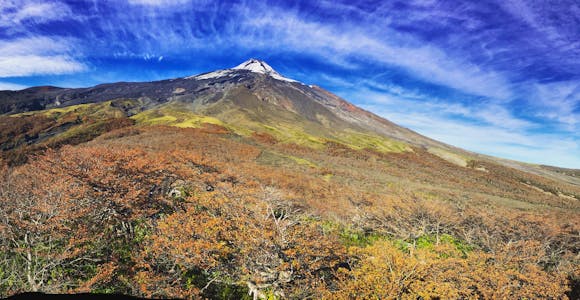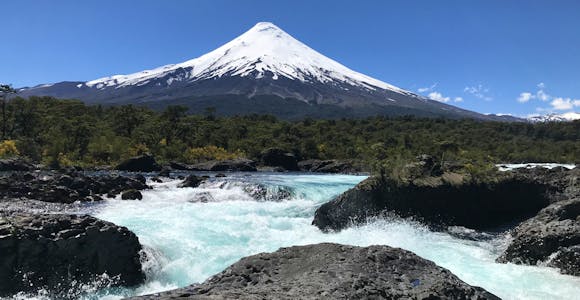
Villarrica National Park
The star power of three volcanoes is what draws visitors to Villarrica National Park on the doorstep of the outdoor sports capital of Pucón.
Discover MoreDeep roots in Patagonia: We are ex-guides, tour leaders, outdoor enthusiasts, & adventurers.
We’ve got our feet on the ground: Impartial advice, a bespoke service, and at no extra cost.
For the ends of the Earth: Sustainability is more than our carbon footprint (but we’re reducing that too).
Deep roots in Patagonia: We are ex-guides, tour leaders, outdoor enthusiasts, & adventurers.
We’ve got our feet on the ground: Impartial advice, a bespoke service, and at no extra cost.
For the ends of the Earth: Sustainability is more than our carbon footprint (but we’re reducing that too).

Spread over the Andean foothills and just a short hop from Chile’s adventure sports capital of Pucón, Huerquehue is one of the region’s most charming national parks. It hosts a network of trails ready-made of day hikers eager to explore the shores of Lake Tranquilco, or to head up into its forests of beech and monkey puzzle trees. The landscape here braided with rivers, hidden waterfalls, hot springs and unexpected views to smoking volcanoes – perfect for easy exploration.

Araucaria trees in Huerquehue National Park
Huerquehue is one of Chile’s oldest protected areas. Covering around 27,500 acres in the Araucanía region, it was first given special status in 1912 under the name of Benjamín Vicuña Mackenna Park (named for the Chilean writer), and was given full national park status in 1967. Its name is a corruption of the Mapudungun word huilquehue or ‘the place of the thrushes’, in reference to the zorzal thrush common to this area.
The park’s close proximity to Pucón and its plethora of well-marked hiking trails make Huerquehue a popular park to visit. The landscape mostly comprises of the Andean foothills running alongside the shore of Lake Tinquilco, and is threaded with rivers and waterfalls and carpeted with trees. Most of its forest is made up of coïgue and lenga trees, both types of Chilean beech, whose leaves paint the park in fiery oranges and yellows every fall. At higher elevations, they give way to the distinctive evergreen araucaria (monkey puzzle) trees. These are the unofficial symbol of Huerquehue, and hiking amongst them its most iconic activity.
Most of the park's wildlife likes to stay hidden, such as the puma and the pudu (the world's smallest deer), as well as the tiny monito del monte or colocolo opossum, one of Chile's only marsupials. Looking to the skies, you stand a good chance of seeing Andean condors rising on the thermals and peregrine falcons. In the woods, look out for the choroy, or green-billed parakeet.
Huerquehue can be visited year-round, although May to September are typically the rainiest months with snow falling at this time at higher altitudes.

Huerquehue National Park
Huerquehue’s trails are well-marked for day hikers. The Sendero Ñirrico is a 4km trail that starts by the park entrance, and gently takes you through coïgue forest and avenues of bamboo to a stunning viewpoint overlooking Tinquilco Lake. The Sendero Quinchol and Sendero San Sebastián trails are slightly longer and climb quickly through coïgue and lenga forest to thick stands of araucaria trees. As you emerge you are gifted with tremendous views that allow you to tick off many of the region’s volcanoes, including smoking Villarrica and Lanín on the Argentina border, as well as the great body of Lake Carbargua.
If you hike north to the end of Lake Tinquilco, the Huequenes Trail (also known as Lago Verde) takes you through woodland to a succession of small lakes: Chico Verde and El Toro. Past Lake El Toro at Renahue there is a small park-run campsite. If you continue from here you can reach the Río Blanco hot springs where you can bathe – and in theory continue your trek along a gravel road that leads eventually to Lake Cabargua.

Luxury villa at Vira Vira
Huerquehue's proximity to Pucón means that most people visit the park on a day trip. If you want to extend your stay, there are numerous official campsites set up along the shores of Lake Tinquilco, which are close the main park entrance, as well as a campsite at Renahue near Lake El Toro that can only be reached by hiking. The Refugio Tinquilco, about 2km inside the park on the Lago Verde trailhead is the only formal accommodation in Huerquehue.
Halfway between Pucón and Hurquehue, the luxury Hotel Vira Vira is one of our favourite places to stay in the region, set in 55 acres of private land, with a host of excursions on hand to explore the park and surrounding area.
The entrance to Huerquehue National Park is just over 30km east of Pucón along the S-095 road. There are daily buses from Pucón to the park entrance, taking around 45 minutes – typically around four a day in the summer high season, and down to twice day in the winter.
Huerquehue is 122km (a two hour drive) from Temuco's Araucanía airport, the main gateway to this region from Santiago.

The star power of three volcanoes is what draws visitors to Villarrica National Park on the doorstep of the outdoor sports capital of Pucón.
Discover More
Discover More

Snowy Osorno Volcano and the blue waters of Lake Todos los Santos usher visitors into one of the most accessible national parks in the Chilean Lake District.
Discover More
Torres del Paine National Park, with its iconic granite Towers, is one of Patagonia's most popular destinations: a paradise for hikers and outdoor adventure activities.
Discover MoreWe'll spend some time listening to your aspirations, then discuss the kind of experience that might suit you.
Next we'll discuss the options, shortlist the best trips for you and present you our impartial recommendations.
We'll place a 24 hour hold on your preferred option - without obligation - whilst we talk through the details.
Whatever your budget, group size, length of stay, preferred activity or appetite for adventure, we can help.
1-888-970-4571This website uses cookies to ensure you get the best experience on our website. Privacy policy